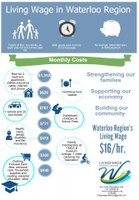Living Wage Waterloo Region Launches Living Wage Employer Recognition Program
Brayden McNeill, Grand River Media Collective
Nov 20, 2016 -- Living Wage Waterloo Region (LWWR) launched its Employer Recognition Program on Tuesday November 4th, commending ten local companies for their progressive wage schemes. LWWR is a local initiative to calculate a living wage for our region and to lobby employers to adapt their pay scales accordingly.
The living wage for our region of $16 per hour was determined with the help of the Canadian Center for Policy Alternatives. It’s based on the needs of a typical family of four, with two parents working full time hours. Calculated using actual costs for public transit, childcare and rent in the Region of Waterloo, the wage is the minimal amount needed for a family to live a comfortable life.
The LWWR groups participating employers into one of 5 tiers; “friends” of the program commit to examining their pay scales within a year, “supporters” pay all their full time employees a living wage, “partners” pay their part time employees that living wage as well, “leaders” add contractors or students to the list, while living wage “champions” provide all direct and indirect employees a living wage.
Three living wage champions were celebrated at the launch, including Enviro-Stewards Inc., GCP Industrial Products Inc. and the Social Planning Council of Cambridge and North Dumfries.
“Living wage and minimum wage discussions can be complementary. A small act that you do on a living wage file might have a ripple effect on a minimum wage file and what we expect there” said CCPA Ontario director Trish Hennessy who spoke at the launch. Hennessy congratulated Waterloo region for joining living wage campaigns across Ontario explaining that besides the obvious benefit for employees, this campaign sets a tone for other discussions.
Noting that the wage paid to employees is usually spent locally making a living wage good for the community at large, Trish went on to explain that a living wage is good for employers as well by reducing turnover rates, training and recruitment costs, “I like the living wage because it can lead to a positive kind of conversation, propositional not just oppositional.”
The program does have its shortcomings. The steering committee for LWWR, which includes seven of the companies celebrated at the launch, doesn’t require any proof of practice from the employers. I spoke to Greg deGroot-Manggetti, chair of LWWRs steering committee. “It’s really based a lot on good faith and good communication with employers. We don’t have the resources to go in and audit an organization, but we do sit down with them and carefully look at their pay scales for example, and they can set up a plan for how they’re going to reach living wage levels. And then it’s up to them to really communicate with their employees and with the community for their commitment to paying a living wage.”
There is also the fear that the program won’t attract larger employers, who typically have more employees being paid less than a living wage. deGroot-Mangetti hopes living wage employers will help advance the cause beyond their own workplace. “The whole aim is to reach out to those sectors of the economy where jobs tend to be lower paid. So one of the things we ask of our employers is to champion the living wage concept, to build it into contracts for bank services, food services, and security services."
Active communication bottom-lines much of this venture with deGroot-Mangetti concluding: "We will be having conversations with employers and different sectors of the economy to bring on organizations from a wide range. We do plan to talk with school boards, the different city and regional councils to make them aware of the program. This program allows them to come on board and put in place plans that will eventually cover all their employees, both direct and indirect such as contracted services.”
Of course LWWR can do nothing more than make our public institutions aware of the program. As always, the impetus lies with the community to see this campaign through. For more information visit www.livingwagewr.org


